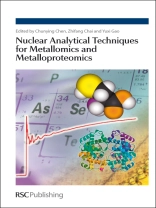Nuclear analytical techniques have many advantages over other techniques, such as high sensitivity and precision. They couple powerful selective separation with sensitive element-specific detection. The uses of metalloproteomics studies are restricted to the fields of analytical and nuclear chemistry. They also have great potential to elucidate the origins of certain diseases and assist in their diagnosis and treatment via the development of new drugs. Nuclear Analytical Techniques for Metallomics and Metalloproteomics provides readers with a comprehensive view of this relatively new and exciting area of bioanalytical and inorganic chemistry. It contains contributions from experts in disciplines as diverse as analytical chemistry, nuclear chemistry, environmental science, molecular biology and medicinal chemistry. Various nuclear analytical techniques are covered including neutron activation analysis, X-ray fluorescence, isotope tracer, M÷ssbauer spectrometry, X-ray absorption spectrometry, and neutron scattering and diffraction. They provide useful information both for chemical speciation analysis and structural characterization of metalloproteins and metals in biological systems. Consequently, the book is not only relevant for chemists involved in nuclear techniques and speciation, but also environmental, nutritional and clinical researchers and drug developers.
विषयसूची
Introduction;
Neutron activation analysis;
X-ray Fluorescence (XRF);
Isotopic techniques combined with ICP-MS and ESI-MS;
M÷ssbauer Spectroscopy;
X-ray absorption spectroscopy;
Protein crystallography for metalloproteins;
Applications of Nuclear Analytical Techniques on Iron-omics studies;
Nuclear-based Metallomics in Metal-based Drugs;
Application of Integrated Techniques for Micro- and Nano-imaging towards the Study of Metallomics and Metalloproteomics in Biological Systems;
Nuclear-based metallomics in metallic nanomaterials: nanometallomics
लेखक के बारे में
Yuxi Gao is an associate professor at Institute of High Energy Physics, Chinese Academy of Sciences. He obtained his Ph D degree in environmental sciences in 2000 from Research Center for Eco-Environmental Sciences, Chinese Academy of Sciences. His current research focuses on the methodology of metallomics and metalloproteomics based on the nuclear analytical techniques; the applications of metallomics and metalloproteomics tourniquets on the environmental and biomedical research; the homeostasis of trace elements and their regulatory mechanism; the structure, function and structure-function relationship of important metalloproteins.












